Seeing my first peacock on a ranch as a child in New Mexico, I was mesmerized, never dreaming I’d be surrounded by them years later in Michigan.
But when I met my husband, then a young stained glass artisan who had acquired a pair of the exotic birds as models for a Tiffany style window, fate began working its magic.
Bill got his first pair of peacocks from his friend Jerry, who purchased them at a yard sale in Ann Arbor for $25, and delivered them in a 1979 Pontiac Trans Am. Herman and Henny Penny lived in a hastily built aviary near Bill’s studio, and the adventure began. Like most species, peacocks want to procreate, and that they do.
Two years after taking a stained glass class from him, I took a leap of faith and married Bill. (I’d taken that leap twice before; had crashed and burned.) But he had never been married, and had every confidence that it would work. Almost thirty four years later, I guess he was right, as usual.
A year after the wedding, though, I was done with life in the drafty pole barn that served as his studio. It was fine for a bachelor, but I was working full-time as a librarian, and it was my turn to be confident. We could afford an actual house.
When we moved five minutes away to the property he owned, the peacocks and guineas we had also acquired moved with us. Bill, his brothers and friends set to work building the first of what would become many bird coops, fashioned with salvaged lumber and poles harvested from our woods. It is long and narrow, with a sloped metal roof, the rafters serving as roosts for the peafowl.
We have a lot.
Over the years I learned that if not confined, peahens will disappear in the spring. I’d mourn their loss until a few weeks later when they’d reappear with an average of four peachicks following close behind.
A few times, two pea hens teamed up and sat on eggs together. One pair hatched their shared brood in an old laundry tub I have in the peacock pen.
Thus, we have had as many as twenty four peafowl at a time. Add the twenty guinea fowl (we love them for their tick eating and alarm call) and the fifty or so chickens, not to mention around ten ducks, and we somehow feed and house over a hundred birds.
It’s a lot.
We’ve rescued quite a few over the years as well. A crippled hen was delivered by my friend Aubrey, whose father had found it on his porch. Others who had wandered away from their previous homes were brought to us as well. And we have one who came in with a flock of wild turkeys! They left, he stayed.
Despite the work, mess, and noise, my life is so enriched by their presence. We are incredibly fortunate to have nearly forty acres of property with no close neighbors, so the noise doesn’t seem to bother anyone anymore. Occasionally the peacock’s cries can be heard in the village of Waterloo, a mile away. Someone there did complain years ago, and the township passed a noise ordinance including the prohibiting of peafowl ownership, but we were grandfathered in.
I’ve learned so much about these remarkable birds. After feeling that we had too many, I re-homed about a dozen peafowl over the years. Most were successful, especially when I learned to give away a hen and her chicks, so they’d adapt to their new environs before they could fly away. But then I read that peafowl form family groups, and I felt guilty about breaking those bonds. Since then, I’ve observed “pods” from four to seven grazing and hanging out together. It’s fun to watch.
They’re very curious birds. When I see a group of them with their heads all turned in one direction at our pond, I know we have a snapping turtle. If pointed toward the field, probably a fox or coyote.
Sometimes young males will attempt to show off their tail feathers. It’s comical.
I’m easily amused. But observing a peacock chasing a guinea in circles around the magnolia tree, and then somehow the guinea turning around and chasing the peacock in the opposite direction, is hysterical. It’s like having our own live Roadrunner cartoon.
Some people believe peafowl are delicate birds, but ours will roost outside in rain and snow, even though they have the option of sleeping inside our four star peacock palace.
One peacock I’ve dubbed Portius roosts outside our kitchen door on the limb of an old crabapple tree in all kinds of weather. Only the coldest of nights will send him inside with the others. He’s done it for years, sometimes startling visitors to our home.
He tends to stay on the north side of the house, lying in the grass near the greenhouse or grazing in the garden during the day. He “shows off” in front of the garage. He often roosts on the poles holding my bird feeders, and comes to parties around our fire pit.
Our oldest peacock, Buddy, possibly closing in on twenty, roosts in an old pen built around a willow tree that was struck by lightning. He used to be so territorial that he would terrorize anyone who came near, unless they were bearing his favorite treat, purple grapes. But thank goodness he’s mellowing in his old age.
My white peahen, Pearlie, was a gift form my friend David. She is beautiful to behold, and very sweet. I do not allow her to free-range because the others pick on her, and she’s an easy target for predators due to her color. When I worried about her being lonely, David came up with a half white male called George. We’ll see if they produce any offspring.
Peafowl have few predators since they’re large and they can fly, but coyotes have been known to chase them, and we did lose two to a Great Horned Owl one summer. It was a terrible reminder of the time I found a dozen beheaded guineas when we still lived at the barn and I was too stupid to know they should be cooped up at night. I sat outside the next night to see if I could find the culprit, and when an owl with a wingspread as wide as my arms swooped in silent as a ghost, I knew, and I ran.
One year we were missing an adult male. (I try to count every evening.) Walking our dogs out back the next day, we came upon a perfectly fanned “bouquet” of peacock tail feathers and assumed a coyote had grabbed him. But a few days later, he reappeared, minus his tail. That’s when I learned of something known as fright, stress or shock molt. Like a lizard, if their tail is caught by a predator, a bird can drop its tail feathers to escape. Since tails help mainly with balance, they can still fly without them. Nature is amazing!
You would think that after living with these beautiful birds for so many years, I’d take their beauty for granted, but I don’t. Each winter as the mature males begin growing their tail feathers, I marvel. As they display their fully feathered tails in spring, I watch in awe. And each summer and fall as I pick up the fallen feathers, I examine each “eye” in wonder at the rich color, texture, and iridescence.
I’m that ten year old girl again, gazing at the peacock on that New Mexico ranch, pinching myself and marveling at my good fortune.


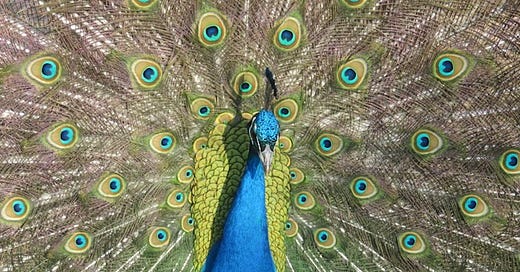



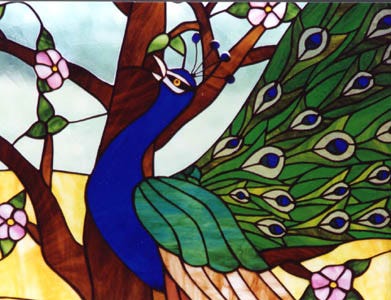


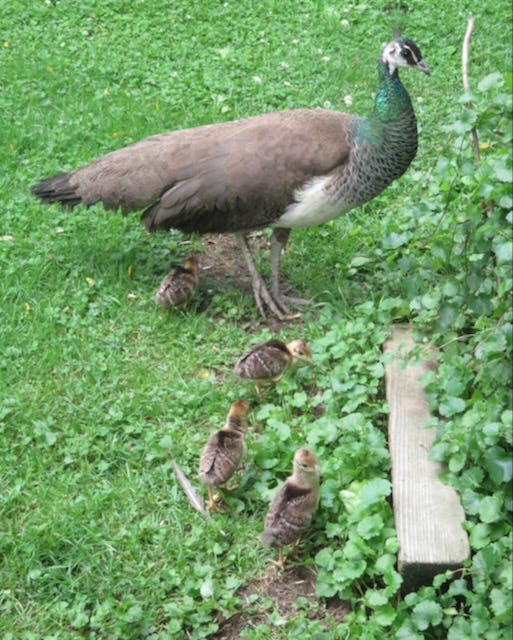


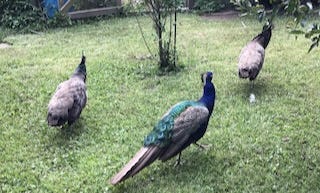

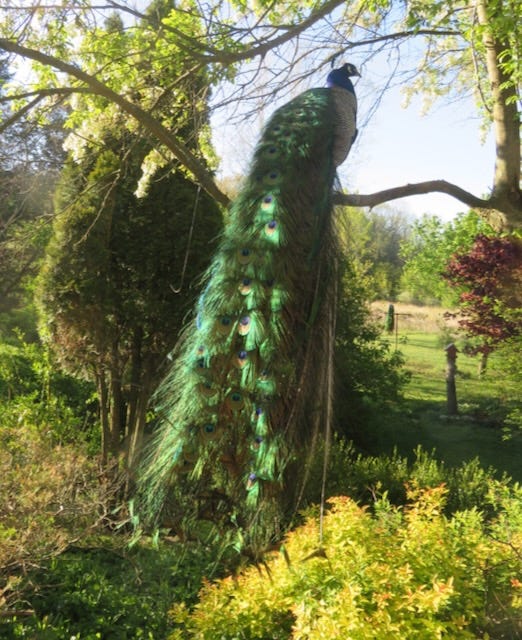
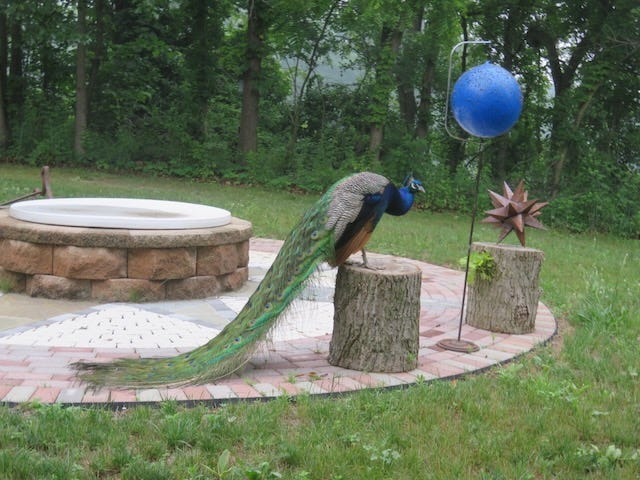
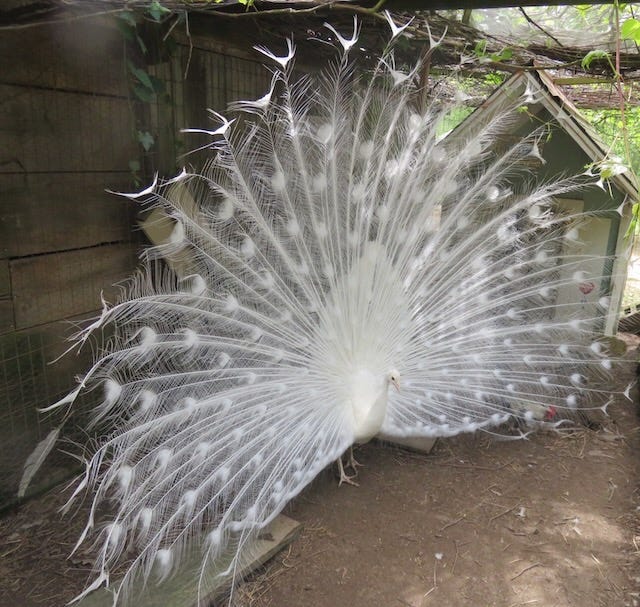

Your observations and appreciation are simply marvelous, like your birds!